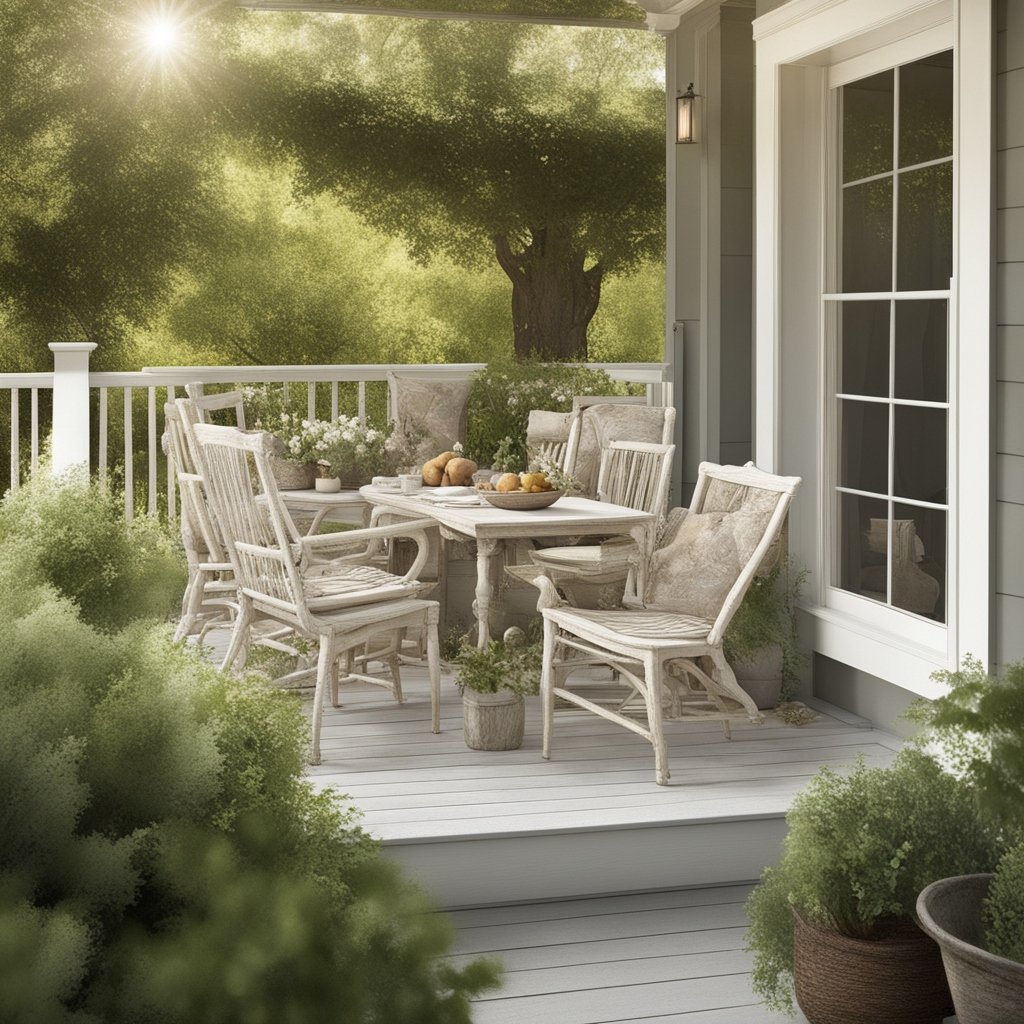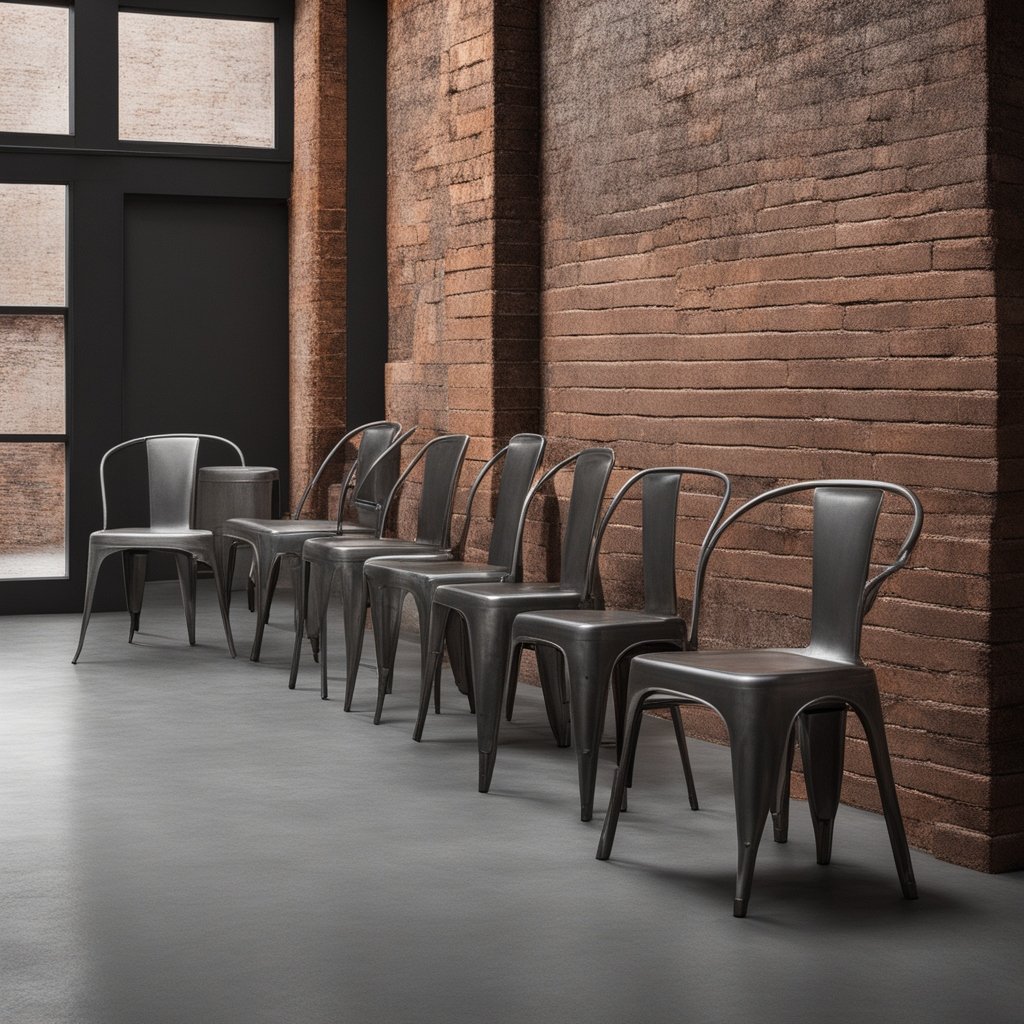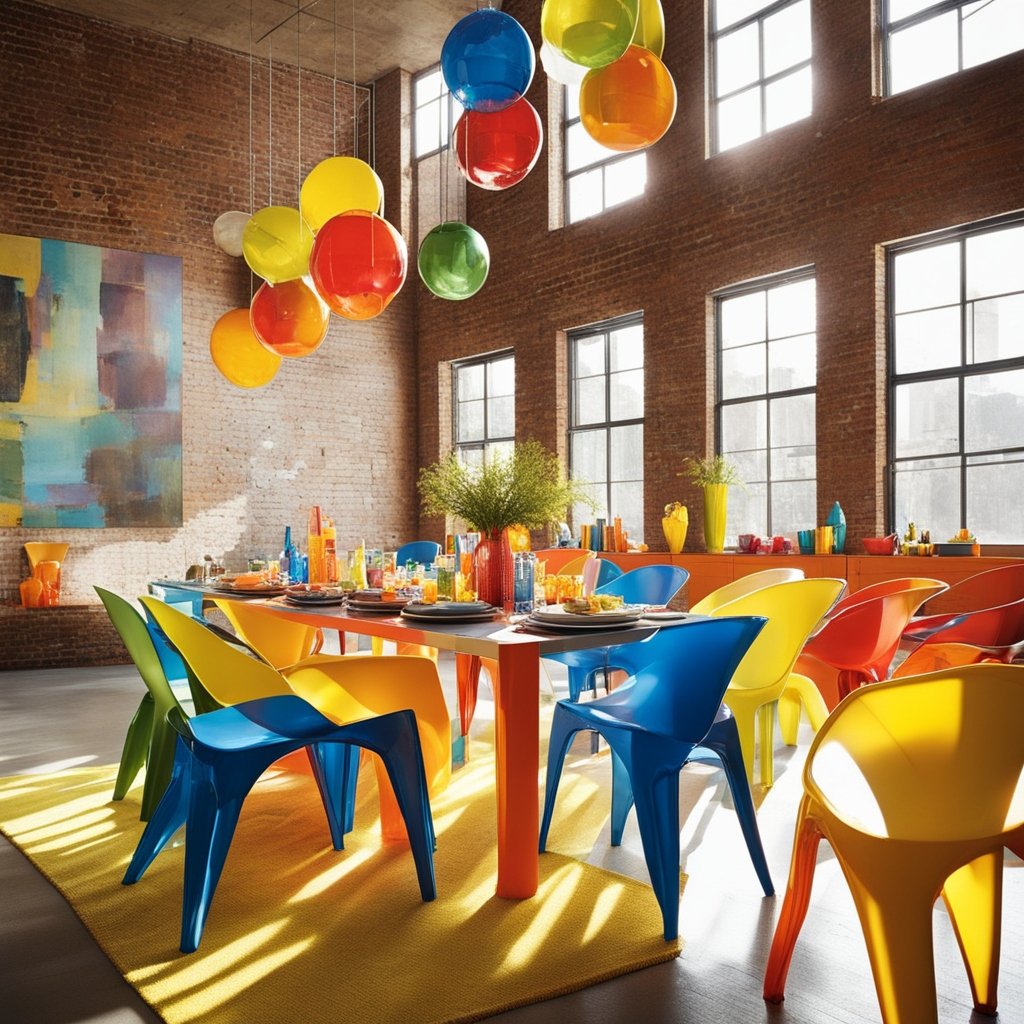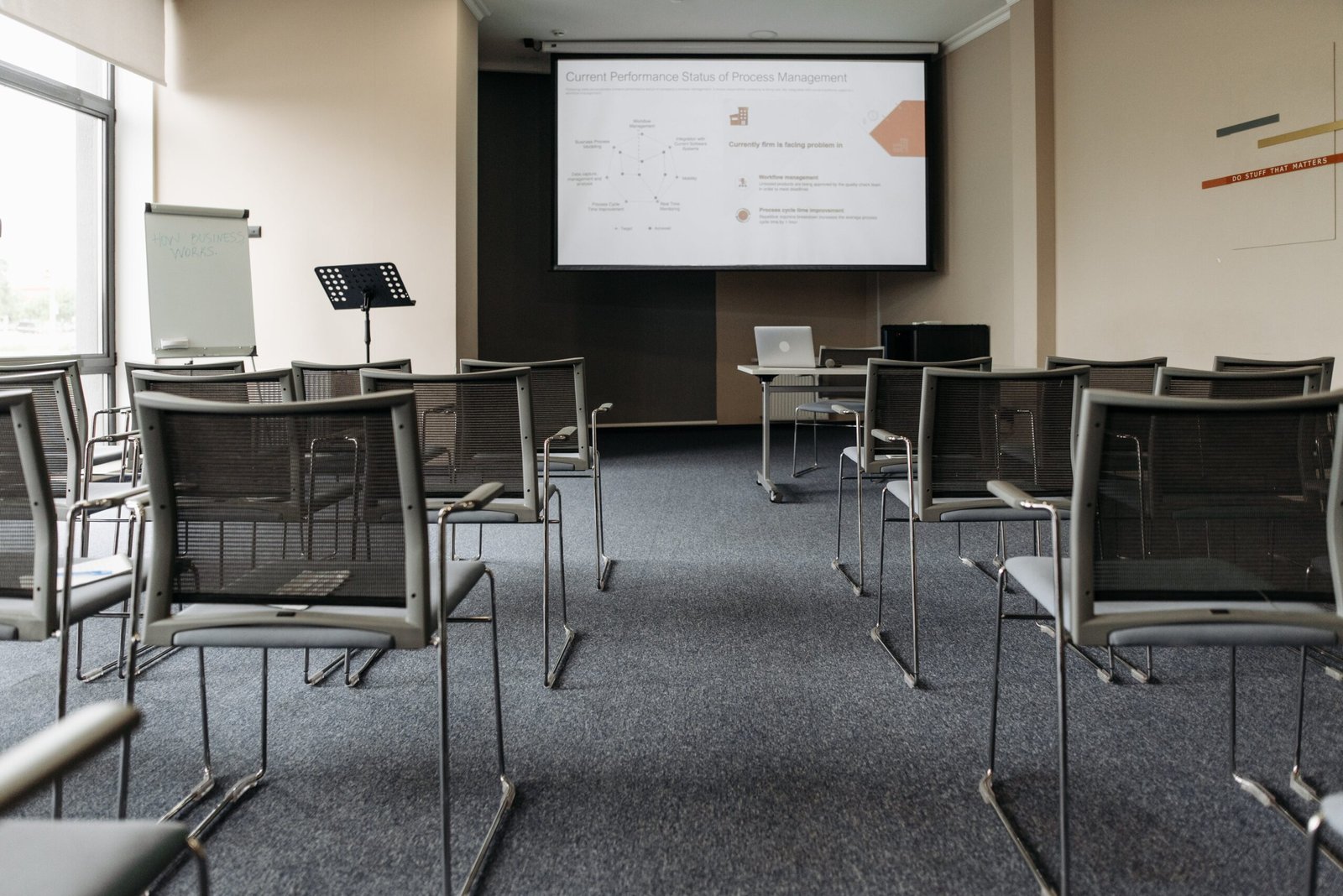Dive into the World of Stacking Chairs: Introduction
Stacking chairs – the name itself speaks volumes about their functionality. These ingenious space-saving wonders are a testament to design’s ability to marry practicality with aesthetics. Unlike their more grounded counterparts, stacking chairs boast a unique party trick: the ability to neatly nestle into one another, forming a compact pile that’s as easy to store as it is to transport.
Imagine hosting a backyard barbecue. The sun is shining, food is sizzling, and laughter fills the air. But as the guest list grows, so does your need for seating. With regular chairs, you’d be scrambling for extra space or wrestling with bulky furniture. But not with stacking chairs! These nimble companions simply rise to the occasion, stacking up like colorful building blocks to create instant seating arrangements.
And when the party’s over? Cleanup is a breeze. No need to lug clunky chairs back inside one by one. Simply gather the stack, effortlessly carry it indoors, and voila! Your patio is transformed back into a serene oasis, with the evidence of your lively gathering neatly tucked away.
The benefits of stacking chairs extend far beyond backyard bashes. These versatile heroes find their place in homes, restaurants, cafes, offices, and even event spaces. They offer efficient solutions for maximizing limited square footage, adding flexibility to seating arrangements, and ensuring smooth transitions between gatherings.
So, whether you’re a space-conscious homeowner, a resourceful event planner, or simply someone who appreciates clever design, stacking chairs are worth welcoming into your world. Get ready to experience the magic of furniture that effortlessly folds into itself, leaving you with more space, less hassle, and endless possibilities.

A Storied Stack: Exploring the History of Stacking Chairs
Stacking chairs aren’t just modern marvels of space-saving ingenuity – they boast a surprisingly rich history, dotted with iconic designs and innovative minds. Let’s journey back in time and unveil the fascinating story of these versatile companions.
Early Seeds of Stackability:
While the concept of stackable furniture stretches back centuries, the specific evolution of “stacking chairs” began in the 18th century. Folding chairs, a staple since ancient times, hinted at the potential for stackable seating. Imagine the X-frame folding chairs used in medieval churches, their scissor-like mechanism foreshadowing the modern stacking features to come.
Industrial Age Innovation:
The 19th century saw the rise of industrial manufacturing, paving the way for mass production of stackable chairs. Michael Thonet’s bentwood chairs, like the iconic No. 14, made in 1850, showcased the possibilities of lightweight, stackable designs using steam-bent wood. These café chairs revolutionized restaurant seating, offering practicality and elegance in equal measure.
Mid-Century Modern Masters:
The 20th century marked a golden age for stacking chair design. The mid-century modern movement, with its emphasis on clean lines and functionality, gave birth to countless iconic stackables. Think of Eames’ Eiffel chairs (1950), those graceful fiberglass beauties perched atop slender metal legs. Or the Tolix A chair (1926), a study in industrial chic with its galvanized steel construction.
Pioneering Plastics:
The latter half of the 20th century saw the introduction of plastics as a game-changer in chair design. Robin Day’s polypropylene “Polyprop” chair (1963) is a prime example, offering affordability and durability alongside its stackable prowess. This design democratized access to stylish seating, finding its way into homes, schools, and public spaces around the world.
Beyond Icons:
Beyond these celebrated examples, countless designers have contributed to the diverse landscape of stacking chairs. From the sleek simplicity of Niels Otto Møller’s J39 dining chair (1947) to the playful pop art vibes of Verner Panton’s stackable heart-shaped chairs (1960s), there’s a stacking chair for every taste and need.
A Legacy of Adaptability:
The evolution of stacking chairs showcases how design responds to changing needs and materials. From humble beginnings to modern masterpieces, these versatile creations have stood the test of time, proving that functionality and style can go hand-in-hand. As we move forward, one thing is certain: the story of stacking chairs will continue to unfold, with new designers and materials pushing the boundaries of what’s possible in this clever corner of the furniture world.
This is just a glimpse into the rich history of stacking chairs. Stay tuned for our next chapter, where we’ll delve into the diverse world of their designs and materials, exploring how these adaptable heroes fit into every space and occasion!

Stacking the Odds: Practical Perks of Stackable Chairs
The mere existence of stacking chairs whispers, “Think outside the box!” – or rather, outside the cluttered floor space. But let’s unravel the magic beyond this nifty feature and uncover the practical advantages that make stacking chairs true household (and beyond) heroes:
Space Conquerors:
Picture a compact apartment bursting with life. Regular chairs would claim square footage like hungry landlords, but not our stackable amigos! Their ability to neatly nestle into vertical towers creates instant floor space liberation. Host unexpected guests? Simply pluck chairs from the stack and voilà, an impromptu seating arrangement blooms!
Portability Pals:
Moving house? Throwing a backyard bash? Stacking chairs become lightweight accomplices in your logistical adventures. No more backaches from wrestling bulky furniture. Simply gather the stack, toss it in the car (or truck, if your guest list rivals a small town), and voila! Your chairs are ready to conquer new territories.
Versatility Chameleons:
These adaptable marvels morph to suit any occasion. Need extra dining chairs for a family feast? Stacking chairs spring into action. Hosting a board game night in the living room? They’ll form a comfy circle in seconds. Setting up a pop-up market stall? These portable comrades are ready to display your wares in style.
Cleaning Champions:
Say goodbye to contorting around chairs like a furniture-dodging gymnast. Stacking chairs make cleaning a breeze. Simply gather the stack, sweep or mop beneath, and return them to their vertical haven. No more furniture Tetris required!
Bonus Perks:
But the benefits don’t stop there! Stacking chairs often boast lightweight designs, making them easy for even the young and elderly to handle. Their compact storage also translates to reduced environmental impact, as fewer materials are needed compared to their bulkier counterparts.
In a nutshell, stacking chairs are the ultimate practical allies. They save space, conquer portability challenges, adapt to diverse needs, and simplify cleaning – all while remaining stylish and comfortable. So, whether you’re a space-conscious urbanite or a party-loving social butterfly, consider welcoming these versatile heroes into your life. You won’t regret stacking the odds in your favor!
A Kaleidoscope of Chairs: Exploring Stacking Styles for Every Need
Stacking chairs aren’t just a one-size-fits-all solution – they come in a dazzling array of materials, styles, and functions, ready to blend seamlessly into any space and occasion. Let’s dive into this colorful world and discover the perfect stackable companions for your needs!
Material Marvels:
- Wood: For a touch of warmth and natural elegance, wooden stacking chairs like the Eames Eiffel chair (1950) or Niels Otto Møller’s J39 dining chair (1947) offer timeless beauty and durability.
- Metal: Stacking chairs embrace the cool, industrial charm of metal with designs like the Tolix A chair (1926) and Eames Wire Chair (1951), perfect for adding a touch of edge to your space.
- Plastic: Affordable, lightweight, and weather-resistant, plastic stacking chairs like Robin Day’s Polyprop chair (1963) and Verner Panton’s stackable heart-shaped chairs (1960s) bring pops of color and playful vibes to any setting.

The Art of Stacking: Unveiling the Design Secrets of Stackable Chairs
Stacking chairs are more than just space-saving marvels; they’re the result of careful design considerations that balance functionality with aesthetics. Let’s dive into the hidden world of these versatile heroes and examine the key elements that make them tick:
Stacking Mechanisms:
The heart of any stackable chair lies in its ability to nestle neatly with its brethren. Common mechanisms include:
- Interlocking legs or frames: Chairs like the Tolix A chair showcase how perfectly angled legs can interlock, creating a stable stack.
- Curved backs: The Eames Eiffel chair’s signature swooping back allows it to rest securely on the seat of the chair below, forming a sturdy pyramid.
- Stacking tabs or notches: Some chairs, like the Emeco Navy Chair, incorporate discreet tabs or notches that guide and stabilize the stacking process.
Standing Tall: Iconic Stacking Chairs that Made Their Mark
In the pantheon of furniture design, stacking chairs occupy a special place. They not only conquer space constraints but also boast innovative forms and enduring aesthetic appeal. Let’s meet three iconic stacking chairs that have earned their place in design history:
1. Eames Eiffel Chair (1950):
This sleek wonder, designed by Charles and Ray Eames, is a masterclass in combining elegance with practicality. Its signature fiberglass seat, supported by slender steel Eiffel-inspired legs, creates a lightweight yet durable chair that stacks effortlessly. The Eames Eiffel chair’s impact goes beyond mere aesthetics; it democratized modern design, making stylish seating accessible to the masses.
2. Bertoia Diamond Chair (1952):
Imagine a chair sculpted from air. Harry Bertoia’s Diamond chair does just that, using delicate steel rods welded into a diamond-shaped form. This minimalist masterpiece is surprisingly sturdy and stacks gracefully, its open form adding a touch of airy elegance to any space. The Bertoia Diamond chair’s enduring legacy lies in its ability to blur the lines between art and furniture, becoming a true sculptural icon.
3. Tolix A Chair (1926):
This industrial beauty, born from the mind of Xavier Pauchard, is a testament to the enduring appeal of simplicity. Crafted from galvanized steel, the Tolix A chair is as rugged as it is stylish. Its clean lines, stackable design, and weatherproof nature make it perfect for both indoor and outdoor spaces. The Tolix A chair’s industrial charm has captured the hearts of designers and homeowners alike, finding its place in everything from cafes and restaurants to contemporary living rooms.
These are just a glimpse into the fascinating world of iconic stacking chairs. From the playful pop of Verner Panton’s heart-shaped chairs to the sleek Scandinavian minimalism of Niels Otto Møller’s J39 dining chair, there’s a stacking chair for every taste and need. So, the next time you’re looking for a versatile and stylish seating solution, remember these design pioneers and explore the endless possibilities of chairs that not only sit, but also stack with grace and ingenuity.
Beyond Storage: Where Stacking Chairs Shine in Every Setting
Stacking chairs are more than just masters of space-saving; they’re chameleons that adapt to various needs and settings, injecting functionality and style into diverse situations. Let’s embark on a journey through different spaces and discover how these versatile heroes bring their magic to life:
Home Sweet Stackable Home:
- Dining Room: Gather the family around a stackable feast! Eames Eiffel chairs or Niels Otto Møller’s J39 dining chairs offer elegance and comfort, while stacking neatly after the last bite.
- Living Room: Need extra seating for movie nights? Plastic stacking chairs like Robin Day’s Polyprop add pops of color and lightweight convenience.
- Home Office: Create a dynamic workspace with foldable chairs that can be stored away after a video call. Monobloc chairs offer space-saving comfort when inspiration strikes.
Beyond the Four Walls:
- Restaurants & Cafes: Picture a bustling bistro with Tolix A chairs stacked gracefully, ready to welcome the next wave of diners. Their durability and stackability make them perfect for high-traffic environments.
-
Events & Conferences: Auditoriums and conference rooms find allies in folding chairs and monobloc chairs, facilitating efficient setup and takedown while providing comfortable seating for large audiences.
-
Outdoor Adventures: Adirondack chairs or weatherproof plastic stacking chairs like Verner Panton’s heart-shaped creations transform patios and balconies into vibrant outdoor entertainment spaces.
The Chameleon Effect:
The beauty of stacking chairs lies in their adaptability. With careful material and style choices, these versatile companions can seamlessly blend into any décor, from minimalist modern to rustic farmhouse. They offer pops of color, industrial chic, or classic elegance, all while saving space and ensuring easy storage.
Stacking for the Future:
As urban spaces evolve and sustainability becomes a priority, stacking chairs offer a smart and eco-friendly solution. Their efficient storage reduces the need for multiple bulky chairs, leading to less material consumption and easier transportation.
So, the next time you’re planning a gathering, furnishing your home, or seeking adaptable seating solutions, remember the magic of stacking chairs. They’re not just space-saving wonders; they’re flexible companions that enhance your life, one stack at a time.
Stacking Your Sustainability: Eco-Friendly Materials in Chair Design
While stacking chairs themselves inherently embody a certain level of environmental consciousness through their efficient storage and use, the materials they’re crafted from play a crucial role in their overall green footprint. Let’s explore some of the eco-friendly materials making waves in stacking chair design:
1. Recycled Plastics:
Plastic stacking chairs, ubiquitous for their affordability and durability, are getting a sustainable makeover. Designers are increasingly repurposing post-consumer plastics like bottles and packaging for chair construction. This not only diverts waste from landfills but also reduces reliance on virgin plastic production, lowering the environmental impact. Notable examples include Emeco chairs made from recycled water bottles and Muji’s stacking stools crafted from discarded fishing nets.
2. Sustainable Wood:
Wood, a classic yet renewable resource, can be a responsible choice when sourced sustainably. Opting for FSC-certified wood ensures your stacking chairs come from responsibly managed forests, minimizing deforestation and promoting healthy ecosystems. Companies like Knoll and Emeco use FSC-certified wood in their stacking chair lines, leading the way in responsible timber sourcing.
3. Bio-Based Materials:
Nature is pushing the boundaries of chair design with innovative bio-based materials. Flaxseeds, bamboo, and even mushrooms are being transformed into sturdy and beautiful chair components. These materials not only have lower carbon footprints than traditional plastics or metals but also decompose readily, minimizing their end-of-life impact. Companies like MATERIAA and NOMA use mycelium (mushroom root structures) to create unique and sustainable stacking chairs.
4. Upcycled & Reused Materials:
There is no end to creativity when it comes to reuse. Stacking chairs are being born from discarded industrial materials like car tires, decommissioned boats, and even scrap metal. This not only breathes new life into waste but also creates unique and characterful pieces that tell a story of responsible design. The Scrapwood Chair by David Trubridge and the Tire Chair by Tokujin Yoshioka are testaments to the artistry of upcycling in chair design.
5. Modular & Demountable Designs:
Stacking chairs can go beyond simply stacking; modular designs allow for disassembly and reconfiguration, extending their lifespan and reducing the need for new furniture production. Additionally, demountable designs facilitate easier recycling and upcycling, further decreasing their environmental impact. The Re-Chair by Re:bar and the Air Chair by Jasper Morrison are examples of modular and demountable stacking chairs that prioritize design flexibility and sustainable material use.
By embracing these eco-friendly materials and innovative design strategies, stacking chairs can truly fulfill their promise of being not just space-saving wonders but also responsible companions for a greener future. So, when choosing your next stackable companions, consider their environmental footprint and support brands championing sustainable materials and practices. Your small choices can make a big difference in stacking towards a healthier planet.
Remember, this is just a glimpse into the exciting world of sustainable stacking chairs. As research and innovation continue, we can expect even more eco-friendly materials and designs to emerge, making responsible furniture choices easier than ever. Stay tuned for the future of stacking, where green design takes center stage!
Crafting Your Stack: DIY Stacking Chair Projects and Customization Ideas
For the hands-on enthusiast, stacking chairs present an exciting opportunity to flex your creative muscles and build your own functional furniture masterpieces. Here are some DIY projects and customization ideas to inspire your inner woodworking artist:
1. Build from Scratch:
Embrace the challenge of crafting your own stacking chairs from scratch! Online plans and tutorials abound, catering to various skill levels and materials. From simple plywood designs like the Plywood Stacking Chair by Ana White to elegant bentwood creations inspired by Michael Thonet’s iconic No. 14, the possibilities are endless.
2. Repurpose & Upcycle:
Give discarded materials a new lease on life by transforming them into unique stacking chairs. Old pallets can be deconstructed and reassembled into rustic yet sturdy seating, while vintage ladder backs can be paired with salvaged lumber to create charming farmhouse-style chairs. The internet is your oyster when it comes to inspiring upcycling projects, so let your creativity guide you!
3. Add a Personal Touch:
Even if you start with a pre-made stacking chair, you can customize it to reflect your unique style. Experiment with paint or stain to inject pops of color or a rustic finish. Play with fabric or leather upholstery to add textural contrast and comfort. Stencils, decoupage, and even mosaic tiles can transform a basic chair into a personalized statement piece.
Stacking the Future: Innovation Taking Chairs to New Heights
Stacking chairs are far from reaching the end of their evolutionary journey. The future promises exciting advances in design, materials, and technology, making these versatile companions even more adaptable and impactful. Let’s peek into the crystal ball and explore some intriguing possibilities:
1. Smart Stacking:
Imagine chairs that can stack themselves! Embedded sensors and actuators could guide individual chairs to form neat and stable stacks, minimizing human effort and maximizing space efficiency. This would be a boon for large venues, event spaces, and even households with limited storage.
2. Material Evolution:
The material palette for stacking chairs will continue to expand. Bio-based materials like mycelium and algae-based polymers offer sustainable and lightweight alternatives, while self-healing materials could automatically repair minor scratches or cracks, extending the lifespan of chairs.
3. Personalization on Demand:
3D printing technology unlocks limitless customization possibilities. Imagine ordering a stackable chair online, selecting your desired size, color, and material, and having it printed on-demand in your own home. This personalized approach would cater to individual preferences and reduce environmental impact by eliminating unnecessary mass production.
4. Connected Chairs:
Stacking chairs could join the internet of things (IoT) revolution. Built-in sensors could monitor weight distribution, usage patterns, and even detect potential safety hazards, sending alerts for maintenance or replacement. This could optimize chair allocation in public spaces, ensure their functionality, and prevent accidents.
5. Multifunctional Marvels:
Stacking chairs could transform into more than just seating. Imagine chairs that fold into tables, lamps, or even planters! This modular approach would maximize furniture utilization in small spaces and offer adaptable solutions for diverse needs.
6. Sustainability Reigns Supreme:
Environmental consciousness will remain a driving force in stacking chair design. Focus on recycled and upcycled materials, modularity for extended lifespans, and efficient production processes will be paramount. The goal is to create chairs that are not just functional but also responsible citizens of the planet.
Beyond the Stack:
While stacking remains the core functionality, future chairs might blur the lines between fixed and mobile furniture. Imagine chairs that seamlessly integrate into wall units, transform into stools or benches, or even morph into other objects when not in use. This adaptability would push the boundaries of space utilization and offer unprecedented flexibility.
The future of stacking chairs is brimming with possibilities. As technology advances and sustainability becomes even more crucial, these versatile companions will continue to evolve, adapting to our changing needs and lifestyles. So, get ready to witness chairs that stack, connect, transform, and most importantly, make our lives more comfortable, convenient, and sustainable. The future of furniture is looking pretty stacked, in the best way possible!
Remember, these are just a glimpse into the boundless potential of stacking chair innovation. As design thinking and technological advancements continue, we can expect even more mind-blowing ideas to emerge, pushing the boundaries of what a chair can be and do. Stay tuned for the exciting future of stacking chairs, where functionality, sustainability, and endless possibilities take center stage!
Conclusion about stacking chairs
In a world where space is precious and style matters, stacking chairs stand tall as champions of both. They are more than just clever storage solutions; they are design chameleons, adapting to diverse needs and injecting functionality and elegance into every setting.
From the airy minimalism of Bertoia’s Diamond chair to the industrial chic of the Tolix A, stacking chairs offer a kaleidoscope of styles that blend seamlessly into modern décor. They effortlessly adapt to your life, transforming dining rooms into vibrant gathering spaces, offices into dynamic work zones, and even balconies into cozy outdoor havens.
But their magic transcends aesthetics. The ability to nestle neatly creates instant floor space liberation, making them ideal for compact urban living and ever-changing needs. They conquer logistical challenges, simplifying transport and storage, and their durable construction ensures they withstand the test of time and frequent use.
Stacking chairs are not just furniture; they are a philosophy of design. They embrace efficiency, adaptability, and sustainability, offering ingenious solutions for our modern lives. They remind us that style and functionality can go hand-in-hand, that responsible material choices and innovative features can enhance our spaces without compromising the planet.
So, the next time you seek versatile seating, embrace the magic of stacking. Look beyond the surface and discover chairs that fold into themselves, stacking not just your furniture, but possibilities. Welcome these adaptable companions into your life, and witness the transformation of your space – functionally efficient, stylishly adorned, and ready to adapt to your every need. Let’s all stack toward a future where furniture is not just about aesthetics, but also about maximizing space, minimizing impact, and enriching our lives in every way possible.
Remember, the story of stacking chairs isn’t just about the past; it’s about the exciting possibilities that lie ahead. As design, technology, and sustainability continue to evolve, stackable companions will keep on innovating, surprising us with their adaptability and style. So, embrace the stack, explore the possibilities, and let these ingenious creations enrich your space and your life. The future of furniture is looking pretty stacked, and we’re all invited to the table!
Who invented stacking chair?
The concept of stacking chairs has been around for a long time, and it's challenging to attribute the invention to a specific individual. The design and use of stackable chairs have evolved over the years, and various designers and manufacturers have contributed to the development of this practical seating solution.
One notable example is the "Monobloc" chair, a lightweight and stackable plastic chair that gained popularity in the 20th century. It was mass-produced and became a ubiquitous choice for outdoor events and casual settings. The exact inventor of the Monobloc chair is not definitively known, as it was produced by various manufacturers. Therefore, the invention of stackable chairs is more of a collective evolution in design rather than the work of a single person.

